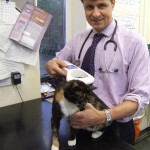Meet Molly a 9 year old Golden Retriever, who had emergency surgery recently for a womb infection (pyometra). Womb infections generally occur a couple of months after the season has finished, and make the dogs feel very unwell, with excessive drinking, loss of appetite and vomiting. The womb fills up with pus like a ‘string of sausages”, and there may or may not be a discharge depending on whether the cervix is open or closed. Unfortunately they do not respond to antibiotics alone and emergency surgery must be performed to remove the infected womb.
Dogs do not go through a menopause, and will keep coming into season all of their life. The risk of a womb infection increases with increasing age, and so we recommend that all female dogs are neutered if possible.
Despite her major surgery Molly was up and around the following day, and her appetite was impressive. She was showing off her paw shaking skills in the kennels for her photo !
Author Archives: hounslowvets

10 Interesting cat facts !
The domestication of cats was based on mutual benefit. In the earliest days of agriculture, people were forced to deal with an unforeseen consequence: rodents devouring crops and spoiling the grain. Following voraciously in their footsteps were predators like snakes and owls—and cats. The cats with the friendliest dispositions were eventually welcomed into human settlements, highly valued for their ability to destroy vermin. The house cat was domesticated from the African wildcat approximately 10,000 years ago in the Middle East and has rarely strayed from our side since.
10 Interesting Cat Facts !
- Sir Isaac Newton invented the cat flap
- It was once thought that the ancient Egyptians were the first to tame cats, but a pet cat has since been found in a 9,500 year old grave in Cyprus
- Cats have around 230 bones in their body, while humans only have 203 bones
- According to the 2010 PAW Report there are 11.9 million pet cats living in the UK
- When cats run they can reach speeds of up to 30mph
- According to the Guinness World Records, the oldest cat lived to be 38 years and 3 days
- Chocolate is poisonous to cats
- A person that loves cats is called a ailurophile
- Julius Caesar was scared of cats, a condition known as ailurophobia
- Cats use their whiskers to judge if they can fit through a hole

Microchipping your cat
Microchipping your cat
Microchipping is one of the most effective forms of pet identification, but too few cat owners have their pets microchipped. The 2011 PDSA Animal Wellbeing (PAW) Report has revealed that 54% of cats in the UK are not microchipped. That’s around 6.4 million cats without microchips.
If cats are microchipped, they are more likely to be reunited with their owners because microchipping is a permanent form of pet identification, unlike collars which can become lost. A cat’s microchip can be read in seconds by a handheld scanner at most veterinary practices or animal shelters.
Cats are naturally inquisitive creatures. Some inspect delivery vehicles and are inadvertently locked inside. There are stories of cats that have turned up hundreds of miles from home and are returned to their owners thanks to their microchips.
We offer cat microchipping at our surgeries in West London. The procedure is quick and often painless – your cat won’t even need to be anaesthetised. Using a syringe, the microchip will quickly be inserted under the skin between your cat’s shoulder blades. It takes no longer than giving a normal injection.
Some cats regularly lose their collars, so microchipping could be a cheaper option in the long run. A microchip will stay with your cat for its entire lifetime. Collars are also a potential hazard to cats as they can easily become snagged on things. Dextrous cats can even get their paws caught underneath a collar, which can lead to painful wounds.
If a cat is believed to be a stray and it is brought into our practice, we will immediately scan it to find out if it has a microchip. If the cat can’t be identified, then it could be rehomed, while its real owner is left forever wondering what happened to their beloved pet.
Call Young Veterinary Partnership today or drop into our practice to enquire about microchipping your cat.
Fear of fireworks in dogs- Video clip
Fear of fireworks in dogs
This is a short video clip of the use of a pheromone- Adaptil- for firework related anxiety in dogs.

Firework related pet anxiety
More than 80% of owners say their pet is afraid of firework noises. Signs of stress in dogs include trembling, shaking, hiding behind furniture, barking excessively, and trying to run away. Cats are much better at hiding their anxiety, but symptoms may include excessive meowing, refusal to eat, hiding, or vertical scratching and spraying.
Often mild reactions to fireworks can be managed with a pheromone (scent) spray; called Feliway in cats and Adaptil in dogs. These products can be purchased from our surgeries.
More severe reactions in dogs may be managed with a combination of sound desensitisation, using CD’s such as Soundsscary, and Adaptil. Occasionally tranquilizers may be prescribed after consultation with your vet, but these are generally used as a last resort.
Further tips for reducing firework anxiety include:
i. Provide a den or hiding place; this works best if it is a place previously chosen by your pet when they have been frightened before.
ii. Plug a Feliway diffuser or Adaptil diffuser close to the den at least a few days before the fireworks start.
iii. Try to ignore behaviour such as whining and crying, panting or pacing. Pets can pick up on their owner’s anxiety, and if you try to soothe them it can reinforce the belief that fireworks are something to be afraid of. It is also important not to scold them.
iv. Close doors and windows, close curtains and turn on music or the TV to mask some of the noises.
v. Keep cats indoors and have them microchipped in case they escape.
Please contact any of our surgeries in West London for further information or a consultation. Please see www.youngvets.co.uk for contact details.

Abandoned kittens get a new home
This summer our vets have seen an increased number of abandoned cats and kittens, compared to normal. The RSPCA do a great job in caring for abandoned or neglected cats and kittens, but they can sometimes be overwhelmed with numbers. We currently have some kittens and young adult cats that need good homes. Please contact our Ealing Young Veterinary Partnership surgery on 0208 5670711 for further information.
We have recently rehomed two of our abandoned kittens. Have a look at these cute videos of them, including one escapologist !

Pet passports- and important travel tips
Pet Passports and important travel tips
- A Pet Passport can be used to travel with your pet to countries within the European Union, and to some countries outside the European union. The requirements for dogs, cats and ferrets travelling within EU and listed non-EU countries are:
- 1- Microchip
2- Vaccination against rabies at least 21 days before travel.
3- Pet passport issued by official veterinarian (Mr A Young or Mr M Wilson are both able to do this at Young Veterinary Partnership)
4- Before RETURN ONLY to the UK dogs must be treated for tapeworm by a vet, 1-5 days before getting on the ferry or plane. ( there is no requirement for cats).
- However you may not be aware that there are a number of diseases that can be caught when your pet travels abroad that we do not have in the United Kingdom. The commonest ones are spread by ticks, mosquitoes or sand flies. It is important to use preventative measures to avoid your pet picking up one of these serious diseases whilst travelling.
Tick borne diseases:
- Babesiosis is transmitted by ticks to dogs and is present in central and southern europe. It causes fever , anaemia, red or brown urine and can cause jaundice amongst other signs.
- Ehrlichiosis– a tick borne disease encountered in Southern Europe and many other countries worldwide. It causes swollen glands, fever and bleeding amongst other signs.
- Hepatozoonosis is another tick borne disease affecting dogs mainly but occasionally cats in countries bordering the Mediterranean. Diagnosis and treatment is difficult.
- Tick control– avoid wooded areas , and areas with livestock, use tick spot on treatments such as Advantix, or a collar such as Scallibor. Also take a tick removal instrument (o’Tom tick twister) and remove any ticks as soon as possible. Remember to start tick preventative treatment BEFORE you travel.
Sandfly and mosquito borne diseases:
- Leishmania– transmitted by sandflies in Spain, France, Italy and other Mediterranean countries, affecting dogs and cats. It causes skin inflammation and ulceration. Prevention is by using sandfly repellants ( started 3 weeks BEFORE travelling), keeping pets indoors from 1 hour before dusk to 1 hour after dawn, and using fly repellants in the house. There is also a vaccine available for dogs, but it needs to be given before travelling.
- Heartworm– affects mostly dogs, but occasionally cats, and is transmitted by mosquitoes. Most southern European countries ( and any with mosquitoes) are affected. It can take many months before symptoms appear and causes weakness, coughing and heart failure. Monthly Advocate spot on treatment is recommended.
- See DEFRA’s website for further details, and a full list of countries included in the Pet passport scheme. https://www.gov.uk/take-pet-abroad
- The British Veterinary Asociation has produced a very useful leaflet outlining the common diseases.The link to the leaflet is
Cleaning dog ears- how to and when ?
- Have a look at this ear cleaning video if you would like any tips on how to clean your own dogs ears. Dogs ears should normally look clean when you look inside, so if there is a dark waxy discharge, you can use an ear cleaner to loosen the wax and clean out the ear. We would recommend coming to the surgery to pick up an ear cleaner, and the nurse or vet can recommend the best one to use.
- If the ear looks very red, has an abnormal smell, or is sore, then you should make an appointment with your vet, to have it checked before using any ear cleaners. Please note that ear mites are usually seen in young puppies ( usually picked up via close contact with their mums), and so it is not appropriate in adult dogs to use mite treatments in their ears without being checked first by your vet.
- Ear problems in adult dogs may be caused by grass seeds, which usually causes acute onset irritation. If present they will need to be removed by a vet, as they are usually lodged deep down at the eardrum level.
- The commonest cause of recurrent ear problems in adult dogs is allergies. It is important to get your dog checked by a vet if ear problems persist or recur frequently.

Choosing your puppy
 New research published in the Veterinary Record has proved the importance of seeing your pups’ parents when choosing a puppy.
New research published in the Veterinary Record has proved the importance of seeing your pups’ parents when choosing a puppy.
Owners who had seen neither parent are 4 times as likely to need to take their dog to see an animal behaviourist. Owners who had seen just one parent (usually the mother) are 2.5 times as likely to have behavioural problems with their dog than owners who had seen both owners.
Seeing the mother allows you to assess the mother’s temperament, its condition and the puppies rearing environment. Ideally your puppy should not be separated from its mother until 8 weeks of age, which also reduces the chances of future behaviour problems. We recommend an eight week health check up with your vet, when the first vaccination can be administered. See www.youngvets.co.uk for contact details of your nearest surgery in Ealing, Brentford, Chiswick or Hounslow.

Breeding a litter of puppies
Many people will decide to let their bitch have a single litter of pups. Most bitches will have a healthy litter of pups without needing any medical intervention. The following is some pointers about the processes involved, and an indication of what is normal.
The mother should be up to date with vaccinations before she is mated. Bitches ovulate around 12 days after the onset of the season, and will normally stand to be mated once the blood spotting has stopped. Two matings 2 days apart at this time are ideal. Once pregnant a monthly treatment with a spot on wormer (Stronghold) will reduce transmission of any worms to the puppies.
The normal gestation period is 63 days (9 weeks), but the time from mating to giving birth can be 63 days +/- 1 week. Providing a warm bed in a quiet and draft free region of the house is a good idea. The mothers rectal temperature will normally drop 1-2 degrees C within 24 hours of giving birth. Once second stage labour has started, and the mother starts strong contractions, a puppy should be produced with 30 minutes. Veterinary attention should be sought if strong contractions have been seen for more than 30 minutes, or if weak straining has been seen for more than 4 hours, or if fetal fluids were seen more than 3 hours without a puppy being produced. Puppies can be produced at intervals ranging from 5 minute to 2 hours. The mother should break the umbilical cord instinctively and lick the puppy clean which stimulates the puppy to breath. If the mother is not doing this then the face should be cleaned of fetal membranes with a towel , and then the towel is used to rub the puppy gently but briskly for 30 seconds, to dry them off and stimulate breathing.
The temperature in the puppy area should be kept warm – around 30 C at birth. Infra-red lamps can be ideal to provide this heat.
Puppies normally feed every 2-3 hours for the first few days after birth. The first milk produced in the first 24 hours is called colostrum, and boosts the immune system. Thus is is very important that all puppies suckle this early milk. They should gain 5-10% of their body weight each day and should weigh double their birth weight by day 10-12.
They should be lifting their heads by 3 days and crawling by 7 days but are usually unable to stand until the end of the third week. They will spend 80% of their time sleeping. Body temperature is lower (35-37C) in new born puppies than an adult dog. The normal breathing is 10 to 20 breaths per minute at birth, increasing to 15-40 breaths per minute by 7 days old. (the smaller the breed the higher the rate).
The puppies eyes are closed at birth and normally open at 2 weeks, and the ears are also closed at birth and open at 14-16 days. There is normally no discharge from the eyes or nose.
Worming can be started from 3-4 weeks of age, and repeated every 2 weeks with panacur. Solid foods can be started from 3 -4 weeks of age by mixing a good quality complete puppy food with some powdered formula bitch milk ( lactol), four times daily.
See www.youngvets.co.uk for contact details for your nearest vet surgery in west london.






